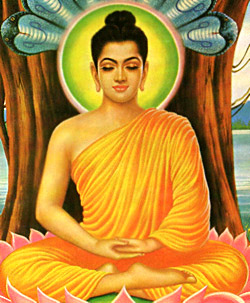 In the language of the Noble Eightfold Path, samyaksamadhi is "right concentration". The elementary way to cultivate Samadhi is meditation. According to Theravada Buddhism, the Buddha taught two types of meditation, viz. samatha meditation and vipassana meditation. Throughout most of Buddhist history before modern times, serious meditation by common people has been most remarkable. Upon development of Samadhi one`s mind becomes sanctified of debasement, quitened, serene, and luminous.
In the language of the Noble Eightfold Path, samyaksamadhi is "right concentration". The elementary way to cultivate Samadhi is meditation. According to Theravada Buddhism, the Buddha taught two types of meditation, viz. samatha meditation and vipassana meditation. Throughout most of Buddhist history before modern times, serious meditation by common people has been most remarkable. Upon development of Samadhi one`s mind becomes sanctified of debasement, quitened, serene, and luminous.
Once the meditator gains a strong and powerful concentration (jhana, Sanskrit dhyana), his mind is ready to get across and earn insight (vipassana) into the ultimate nature of reality, eventually obtaining freedom from all suffering. The cultivation of mindfulness is indispensable to mental concentration (samadhi), which is needed to attain insight.
Samatha Meditation commences from being mindful of an object or idea, which is exposited to one`s body, mind and entire surroundings, leading to a state of total concentration and tranquillity (jhana) There are numerous variances in the style of meditation, from sitting cross-legged or kneeling to chanting or walking. The most common method of meditation is to focus on one`s breath, because this practice can lead to both samatha and vipassana.
In Buddhist practice, it is stated that while samatha meditation can calm the mind, only vipassana meditation can reveal how the mind was perturbed to start with, which is what leads to jnana (Pali ñana knowledge), prajna (Pali pañña pure understanding) and thus can lead to nirvana (Pali nibbana). When one is in jnana, all corruptions are suppressed for a transient moment. Samadhi, is thus achieved. Only prajna or vipassana extinguishes the defilements entirely. Jhanas are also resting states which arhats abide in order to rest.



















